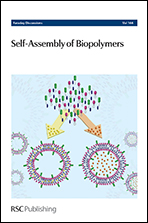Coiled-coil driven membrane fusion: zipper-like vs. non-zipper-like peptide orientation
Abstract
Membrane fusion plays a central role in biological processes such as neurotransmission and exocytosis. An important class of proteins that induce membrane fusion are called SNARE (soluble N-ethyl malemeide sensitive factor attachment protein receptors) proteins. To induce membrane fusion, two SNARE proteins embedded in opposing membranes form a four-helix coiled-coil motif together with a third, cytoplasmic, SNARE protein. Coiled-coil formation brings the two membranes into close proximity allowing fusion to occur. Importantly, structural investigations have demonstrated that native membrane fusion only occurs when the orientation of the coiled-coil motif resembles that of a zipper. The zipper orientation arises when parallel coiled-coil formation takes place between peptides that are anchored into apposing membranes at identical termini, thereby forcing the membranes into close contact. Recently, we have designed a synthetic model for membrane fusion, which is based on a set of lipidated coiled-coil forming peptide pairs which are denoted E–K. When incorporated into liposomal membranes, coiled-coil formation between these lipidated peptides induces targeted and efficient membrane fusion of liposomes. Our model system mimics SNARE-driven membrane fusion, as it contains a coiled-coil motif which has a zipper-like orientation, similar to that of the SNARE proteins. Here we investigate whether the zipper-like orientation of the coiled-coil motifs is a prerequisite for membrane fusion in our model system. Our strategy is based on conjugation of the transmembrane anchor to either the N- or the C-terminus of peptides E and K. Whereas the use of a set of complementary peptides with the membrane anchor on identical peptide termini yields the zipper-like orientation of the coiled-coil complex, membrane anchors on opposite peptide termini results in a non-zipper-like coiled-coil orientation. Surprisingly, it was observed that efficient and targeted membrane fusion was induced even when the coiled-coil motif did not form the zipper-like orientation. This demonstrates that for our model system, the zipper model for membrane fusion does not apply.
- This article is part of the themed collection: Self-Assembly of Biopolymers

 Please wait while we load your content...
Please wait while we load your content...